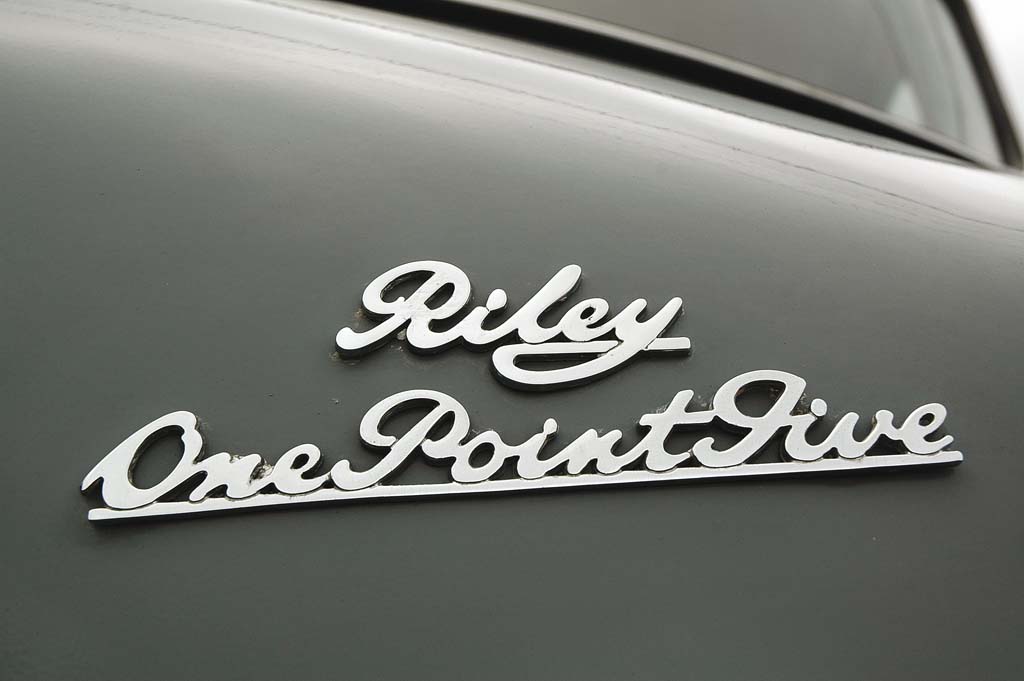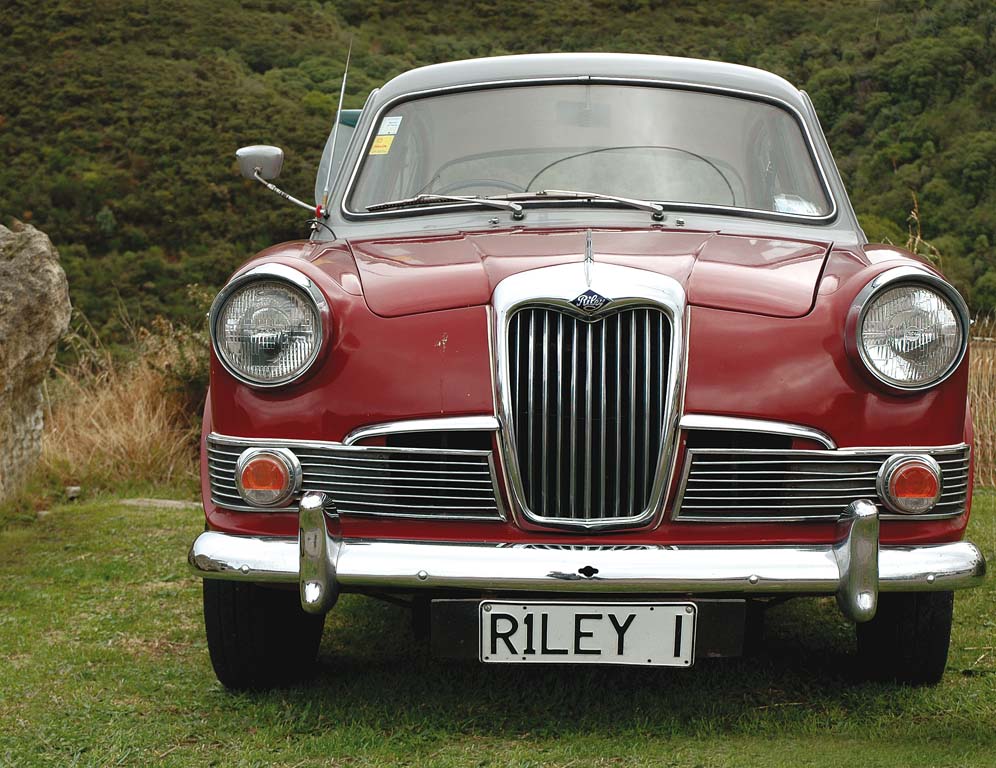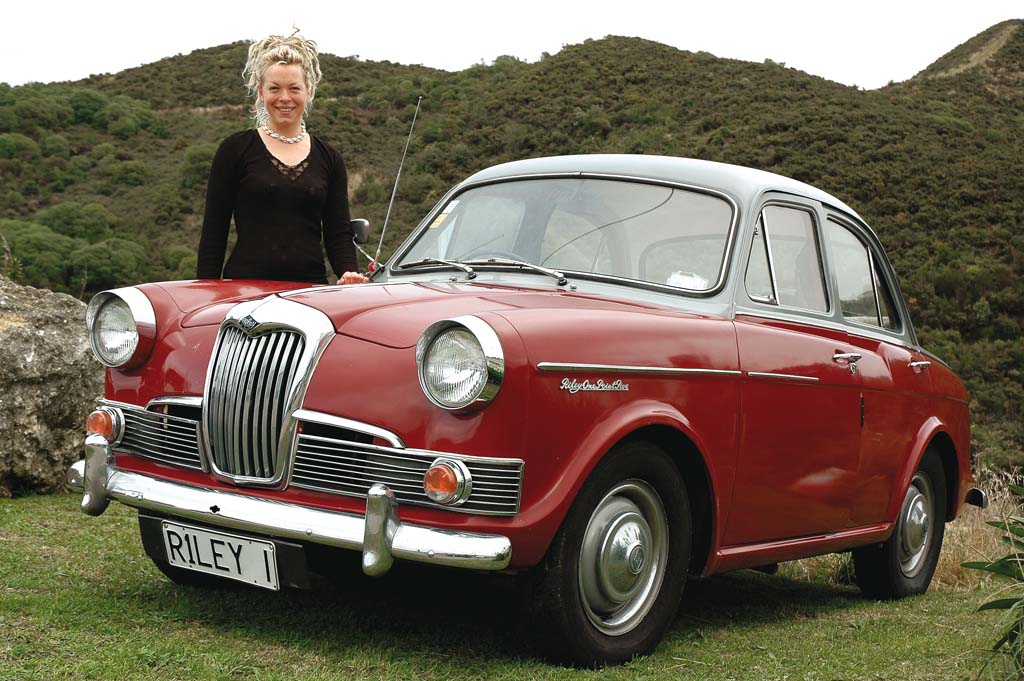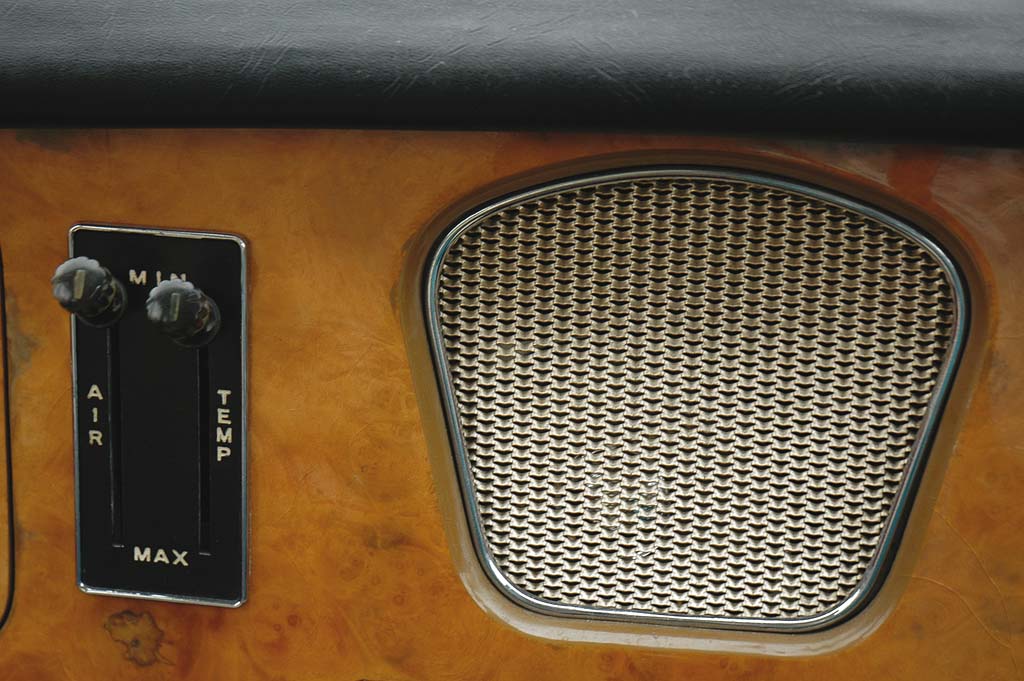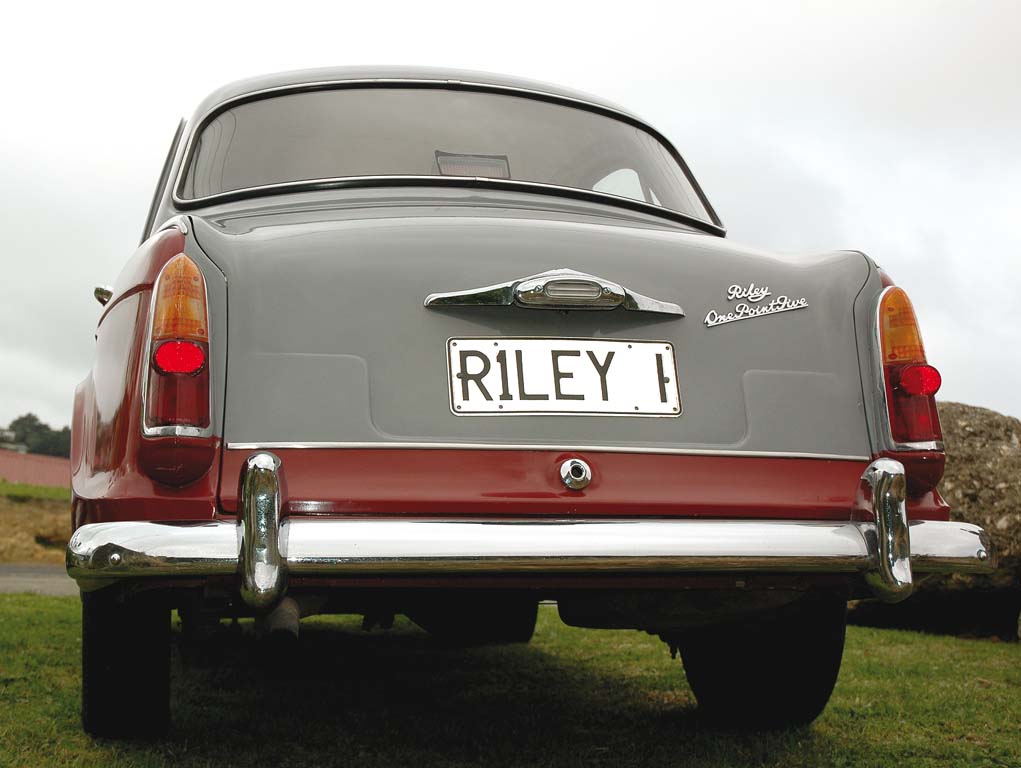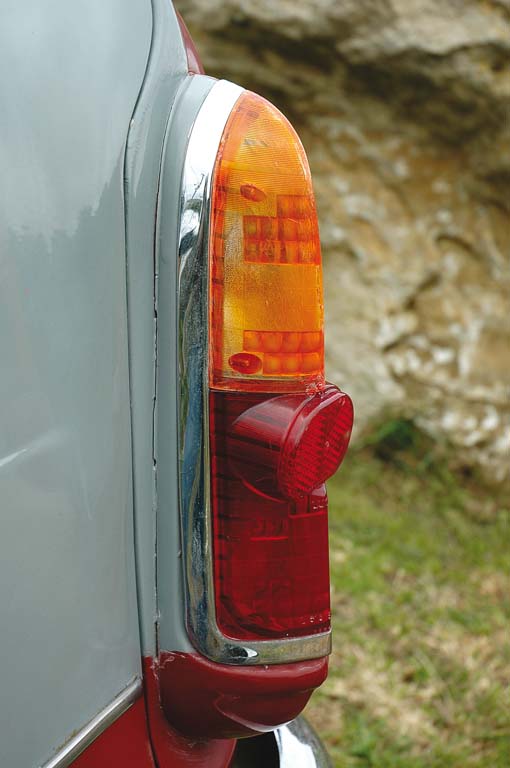data-animation-override>
“Published in New Zealand Classic Car Issue No. 200”

Tim once raced his father’s Riley One Point Five at Ohakea. Now he takes a trip back through time to inspect a similar Riley which has been leading the good life in Wellington
Sam Auger is a busy man. I visited his house, met his wife Sarah, purchased a Vespa scooter from him and inspected his smart Riley One Point Five, but had never met the multi-talented designer and ukelele concert band member.
Although arriving at the Augur’s address wearing one of my other hats as a member of the New Plymouth Chapter of the Magnetos Scooter club, to inspect a Vespa, I ended up gravitating towards a charming two-tone BMC Riley. Nostalgia had drawn me towards the pert little British car because in my past, three different BMC Rileys played their part in getting me hooked on classics when I was a younger man.
My first car, which I owned for 20 years and raced in the first classic car races held at Manfeild, was a 1962 Riley 4/72. This faithful motor saw me well beyond the student years it was initially intended for. Then there was the little Riley Elf which had belonged to my high school art teacher, and which became my mother’s ‘shopping basket’ before my father pressed it into a dual role and took it classic car racing. Finally, there was the Riley One Point Five (often referred to as the 1.5 to save words) which my father purchased from Wellington, and restored as a purpose-built classic race and club car.
His burgundy-coloured One Point Five raced the length and breadth of the country, from Dunedin to Pukekohe, during the ’90s and I was lucky enough to race it myself at that sadly missed circuit at Ohakea airbase. All three of our family Rileys have moved on to other North Island addresses, but I still get a large whiff of nostalgia for the BMC Rileys whenever a blue diamond-badged grille hoves into view.
Morris Minor antecedents
The Augur’s Riley is a 1962 model which was first registered in New Zealand on March 28 that year. Unlike the similarly-bodied Wolseley 1500, the Riley versions of this particular arm of BMC ‘badge engineering’ are rarer in New Zealand and often mistaken for Wolseleys at a distance.
Both of these sporty saloons were based on the Morris Minor floorpan (as with the Australian Austin Lancer/ Morris Major) and given a good spread of interior wood finish and leather seating.
The Riley 1.5 gained twin SU carburettors as standard when it left the Abingdon on Thames BMC factory, and this put it in the realm of sports saloons back in the late ’50s when it first appeared at the start of its 1957-’65 production run.
British race driver Les Leston, who drove briefly for Connaught, Cooper and BRM in Formula 1 during the ’50s, probably gave the 1.5 model its finest days of glory when he won the British saloon car championship in one of the nimble Rileys back in 1958. Pat Moss, the sister of Formula 1 ace Stirling, did well in her factory backed ‘works’ 1.5 in European rallying events, along with co-driver Ann Wisdom. The pairing won the Ladies Cup at both the 1958 Circuit Of Ireland Rally and the 1959 Sestrieres Rally.
Here in New Zealand the few appearances by the little Rileys on our race tracks probably reflected their comparative rarity here. While Wolseley 1500s more often made the entry lists on our race programmes — such as the legendary one pedalled by Feilding’s Roger Redmayne. In the research for my first saloon car racing book, published back in 1999, I could only find the one Riley 1.5 race entrant in New Zealand — a Mr G Huddleston, who entered example in an endurance race at Timaru as late as 1969, when the model was already dated — until my father rolled his restored Riley out of his Hawera garage, and headed off to Manfeild in the early ’90s. Riley 1.5 saloons are of course really Morris Minors under the skin, and even for production-based classic car racing, my father had to make some adjustments to create a safer, better-handling vehicle without ruining the original character of the classic car, or hot-rodding it to try to keep up with the ‘cheque book’ racers who had started to ruin classic car racing in the ’90s with their ‘silhouette’ cars.
Leather and Walnut
Our featured Riley 1.5 from Wellington boasts the aroma and refinement of both leather seating and polished walnut, which came standard on the 1.5, the last time leather would commonly be seen on any Riley in New Zealand before the marque ceased to exist.
The last Austin Cambridge-based Riley 4/72 and Mini-based Elfs were fitted with vinyl seating for the colonies. Quality trim and finish were always Riley hallmarks, right through the Nuffield period and on into the terminal BMC days. When BMW came to own the rights to the deceased British Leyland mausoleum of marques such as Rover, Riley, Wolseley, MG and Mini, many of us who were Riley club members waited with baited breath for a refined modern Riley Elf, Pathfinder or Kestrel to reappear in the character of the old, but to no avail.
Frontally the traditional Riley grille and blue diamond badge totally disguise the model’s Morris Minor origins, a stylish design makeover, but my personal feeling is that the rear of the car has a dumpy look, more in keeping with what critics called the ‘Aunty Rover’ look than that of a sporting saloon. Understated fins such as those on the early ’60s Sunbeam Rapiers without the pointedness of those on the Australian Morris Major may have been more suitable.
Aesthetically speaking, the roof-line is curvy like the Morris Minor with the roundness extending down to the rear. A pinched waist is a feature of the car’s body shape from the side.
The rear taillight lenses on these later Riley 1.5s will look familiar to Austin owners, as the MkIII Riley 1.5 taillights were shared with the Austin A40 Farina model. Such sharing was quite normal in the days of BMC, where the parts bin was sometimes treated a bit like a lucky dip, but often to good effect.
Early Riley 1.5s had small sharp-edged chrome surrounds with tiny taillights. Solid chrome over brass made for long lasting and durable bumpers at both ends of the Riley, as well as for its sharp-edged headlamp eyelids, which would today seriously fail any pedestrian safety test. However, car enthusiasts of the ’60s never complained about chrome edges and embellishments.
Identity Crisis
Some people have suggested that the Riley 1.5 and its sister Wolseley 1500 didn’t really know what they were. Their alleged identity crisis alluded to the fact that the short chassis and torquey B-series engine gave sporty performance, but the car itself was still trying to be an upright, staid semblance of an English manor on wheels.
Riley’s company motto was always, “As old as the industry — As modern as the hour.” Perhaps that sums up what the Riley 1.5 was really all about — a car with connections to traditional English craftsmanship, while looking ahead to the downsizing of cars and the creation of the sports saloon or GT. Sunbeam was also doing this with its Rapier model and then, of course, along came the Ford Lotus-Cortina, and the whole small sporty saloon concept would never be the same!
Sam Augur’s Riley One Point Five (to g
o back to its correct elongated name form) now stands alongside those cherished BMC Rileys in the NZ Riley Car Club as reminders of times past when BMC produced a wide range of models to choose from, and the blue diamond Riley badge stood for a well engineered and comfortable car.
Sam and Sarah Augur have now winged their way across the globe to the nether land of the belt-driven Daf on a spot of OE, and this little Riley has recently come up for sale as result. In the meantime it is being cosseted and cared for in the capital by the local branch of the Riley club, until a new owner slips behind the walnut and dashes off to lead ‘the life of Riley.’
Riley One Point Five (1957-65) – Specifications
Engine: ¨Four-cylinder BMC B-series
Capacity: 1489cc
Bore/stroke: 73.025×88.9mm
Valves: ohv
Max power: ¨51kW (68bhp) at 5400rpm
Fuel system: Twin SU
Dimensions
Length: 3899mm
Width: 1549mm
Wheelbase: 2184mm
Track: 1289mm
Performance
Max speed: 137-145kph (85-90mph)
Standing 1/4: 21.1 seconds
Economy ¨Approx: 10l/100km (28mpg)
Words & Photos, Tim Chadwick

